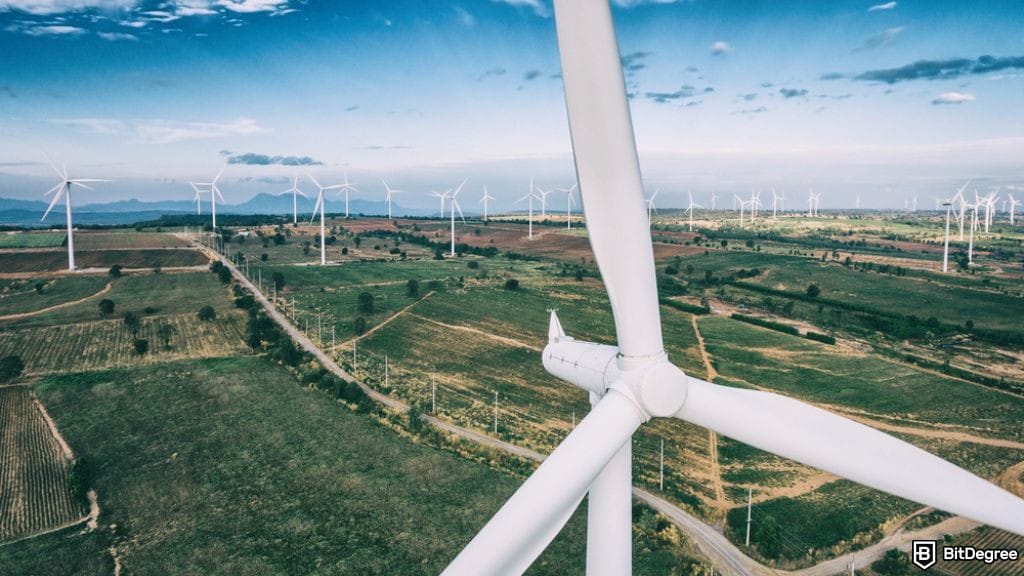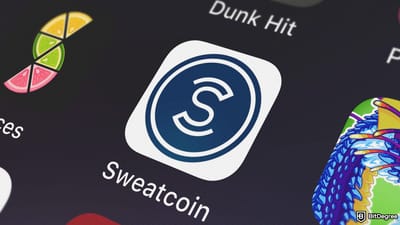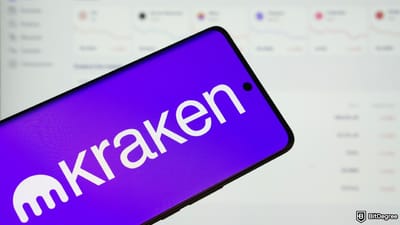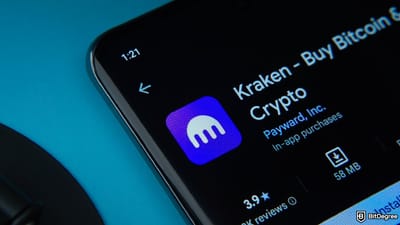Key Takeaways
- VeChain offers a full-stack ecosystem, complete with its own blockchain, wallet, DAO, dApps platform, and real-world use cases that make sustainability easy;
- VeChainThor, its blockchain, helps tackle real-world challenges like carbon tracking, supply chain transparency, and sustainability;
- Through dApps like GreenCart, Mugshot, and Cleanify on VeBetter, users can get rewards in B3TR tokens for making eco-friendly choices.
Stop overpaying - start transferring money with Ogvio. Sign up, invite friends & grab Rewards now! 🎁
Many people associate blockchain with environmental concerns, and that’s exactly where VeChain steps in. So, what is VeChain, exactly? It’s an ecosystem built for tackling real-world challenges, like cutting carbon emissions and helping businesses earn consumer trust.
VeChain is powered by its token called VET, listed on major exchanges like Binance or Bybit. It's more than just a trading asset, as you can stake it, use it for transaction fees, and access real utility through apps that reward sustainable behavior.
So, for those who are sustainability advocates, businesses ready to disrupt outdated systems, or crypto explorers seeking real-life impact, this VeChain review is for you. What you’ll discover about this ecosystem may just change the way you see blockchain.

Did you know?
Subscribe - We publish new crypto explainer videos every week!
What Is a Neobank (And Should You Use It)?


Table of Contents
- 1. What is VeChain?
- 2. A Brief History of VeChain
- 3. How Does VeChain Work?
- 3.1. Proof of Authority 2.0
- 3.2. Dual-Token Economic Model
- 3.3. Enterprise Features
- 3.4. VeChain Governance
- 3.5. VeBetterDAO and VeBetter
- 4. VeChain Staking and Rewards Mechanism
- 5. Benefits of Using VeChain
- 6. The VeChain Blockchain: Use Cases
- 7. Conclusions
What is VeChain?
VeChain is a blockchain ecosystem and creator of VeChainThor, a Layer-1 enterprise-grade blockchain. It bridges the gap between blockchain technology and sustainability, powering companies with a low-carbon, scalable platform.
Latest Deal Active Right Now:In practice, blockchain can be a shared system[1] where all participants are informed of every event and transaction through a secure, public record.
VeChain, specifically, aims to enable them to create cleaner supply chains, accountable enterprises, and informed consumption. For example, it helps trace ethically sourced coffee beans or verify carbon offset claims.
In its latest whitepaper titled Web3 For the Better, VeChain’s vision is to:
Multiply individual impact to unleash our collective potential for sustainability.
To put the vision into action, VeChain builds an eco-friendly ecosystem with its blockchain, named VeChainThor. It combines high performance, energy efficiency, and user-friendly features to lower the barrier for businesses to enter Web3.
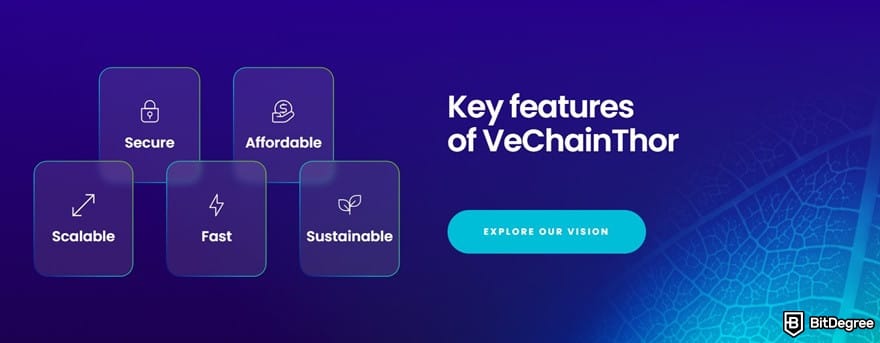
Its core innovations, including a dual-token economy (VET and VTHO) and fee delegation, help businesses adopt blockchain without burdening them with complex transaction mechanics or unpredictable costs.
Unlike many blockchains that focus purely on finance or speculation, VeChain puts real-world utility first. Global enterprises, such as Walmart China and LVMH, use VeChain’s solutions to track fresh food products and authenticate luxury products from brands like Dior and Louis Vuitton to combat counterfeiting.
📚 Read More: Blockchain in Supply Chain
A Brief History of VeChain
Founded in 2015 and headquartered in San Marino, Europe, VeChain began with a clear mission: to use blockchain technology to improve transparency and efficiency in supply chains.
The project was launched by Sunny Lu, former CIO of Louis Vuitton China, and initially incubated under BitSE in China. Drawing on real-world enterprise experience, VeChain is set out to build a blockchain platform for businesses, which was largely missing from the early crypto landscape.
In 2016, VeChain released its first consortium blockchain prototype. This early version laid the groundwork for enterprise applications and allowed the team to explore integration with the Internet of Things (IoT), which is a major part of its long-term vision.
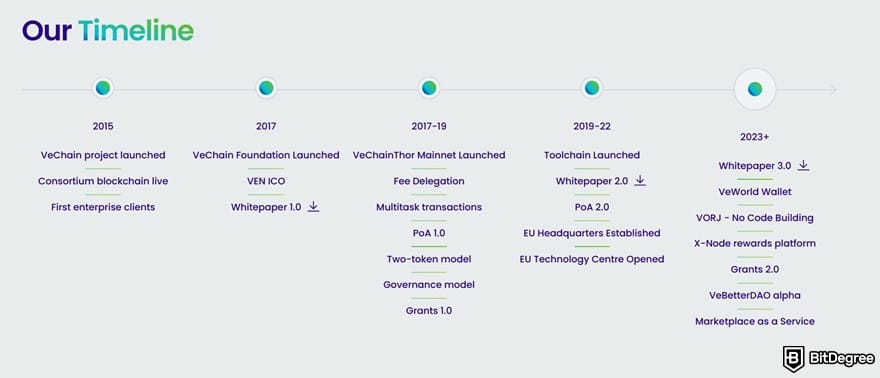
By the following year, VeChain had gained momentum. It conducted a successful Initial Coin Offering (ICO) for its original VEN token and released Whitepaper 1.0, outlining its technical and business goals. Notably, it also built partnerships with PwC and DNV, two of the world’s leading professional services firms, which helped establish its credibility among enterprises.
A major turning point came in 2018 with the launch of the VeChainThor mainnet. This introduced several core innovations that still define the network today, including:
- The Proof of Authority (PoA) consensus mechanism;
- Two-token system (VET and VTHO);
- Fee delegation model;
- Multi-clause transactions;
- Early governance frameworks.
Alongside this technical progress, the team also introduced a developer grants program to encourage ecosystem growth and attract positive user VeChain reviews.
Between 2019 and 2022, VeChain launched ToolChain, a no-code product suite that helped businesses onboard without requiring deep blockchain expertise, expanded its European operations, upgraded to PoA 2.0, and published Whitepaper 2.0.
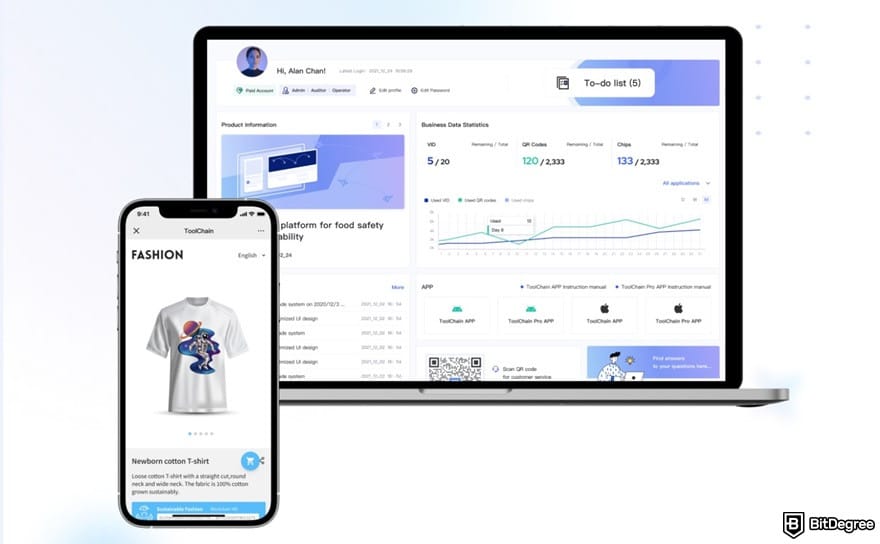
In 2023, VeChain entered a new phase with the release of Whitepaper 3.0, the VeWorld wallet, the VORJ no-code smart contract builder, and the launch of VeBetterDAO in alpha. This new ecosystem uses an "X-to-Earn" model to reward positive actions related to sustainability and social impact.
It signaled VeChain’s broader vision – one that includes public engagement, Web3 tools, and grassroots governance.
At the time of writing, VeChain is undergoing a major evolution through a multi-phase roadmap called the VeChain Renaissance:
1
The Galactica phase. This introduces typed transactions, the Shanghai EVM upgrade, and a dynamic gas fee market that burns 100% of VTHO.
2
The Hayabusa phase. It aims to bring an updated VeChain staking platform called StarGate, complete with NFTs and community participation.
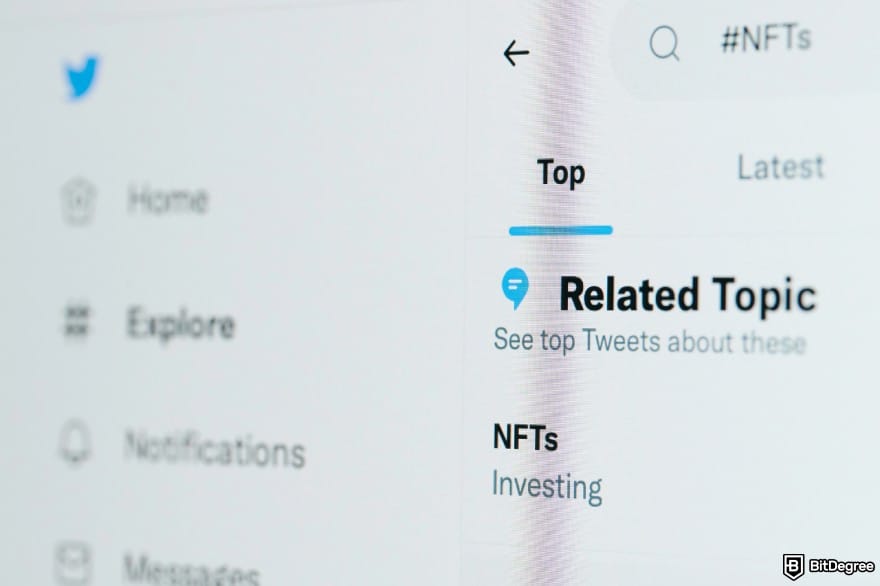
3
The Interstellar phase. It delivers full EVM compatibility and JSON-RPC support, making VeChainThor more interoperable with the broader Ethereum ecosystem.
3
Looking ahead, VeChain is positioning itself as more than just a blockchain for supply chains. With enterprise roots, eco-conscious tools like VeBetterDAO, and a developer-friendly infrastructure, it aims to power real-world applications at scale, without compromising on sustainability or user experience.
How Does VeChain Work?
The VeChainThor blockchain builds its foundation with Ethereum but adds its own twist to be more efficient, business-friendly, and ready for real-world use cases.
In short, it works by combining blockchain technology with its Proof of Authority (PoA 2.0) consensus, a unique two-token system, and data integration. Then, tools like IoT integration and no-code platforms help businesses adopt blockchain without the complexity.
Proof of Authority 2.0
VeChainThor’s consensus, Proof of Authority 2.0, is designed for scalable and energy-efficient governance. Only 101 authority masternodes (called Authority Masternodes or AMs) are needed to confirm transactions, and each one is verified and backed with a stake.
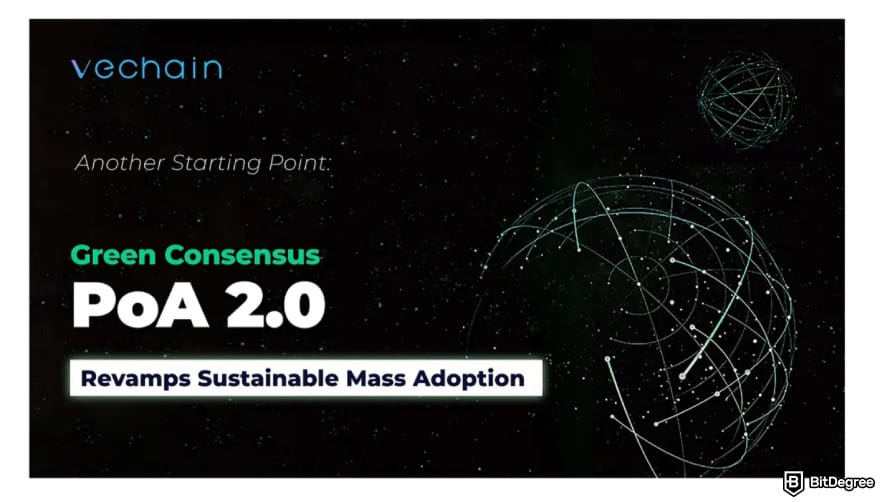
These masternodes are chosen through a strict process and are held accountable, meaning they have a strong incentive to act honestly. Because these validators are known and verified, VeChainThor avoids the randomness and inefficiency of traditional mining, resulting in lower energy consumption and higher performance.
The network uses minimal energy, estimated at around 0.000216 kWh per transaction, or ~4.46 t CO₂e/year for the whole network.
A new block is added to the VeChainThor blockchain every 10 seconds. The validator who gets to produce the next block is selected by an algorithm called Deterministic Pseudo-Random Process (DPRP). This ensures every validator has an equal chance of being chosen, without bias, making the block production process more predictable and fair.
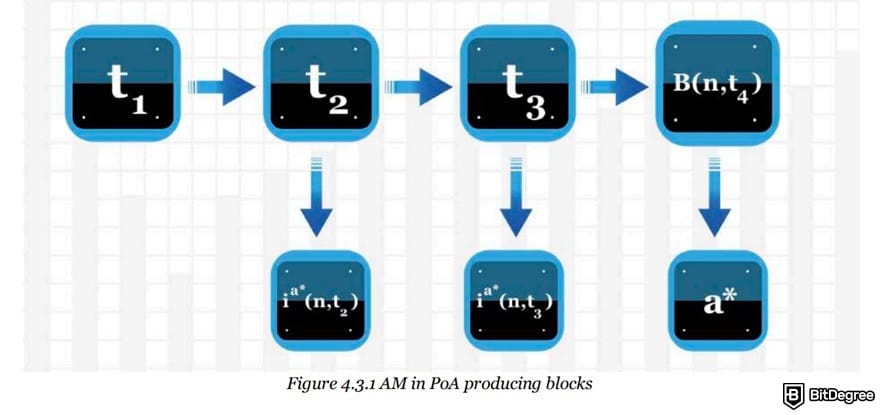
To avoid forks (or to resolve them quickly when they happen), VeChainThor uses a system of "witness votes". If two blocks appear at once, validators cast votes to support the block they believe is valid.
The chain with more witnessed support becomes the main chain, using a system called Accumulated Witness Nodes (AWN). This ensures that the data on VeChain remains consistent and tamper-proof, which is a critical factor for supply chain and sustainability use cases.
PoA 2.0 brings several improvements to VeChain’s original consensus design. First, it includes a feature called Verifiable Random Function (VRF), adding strong, cryptographic randomness to the selection of the next block producer. This makes it nearly impossible to predict or manipulate block production.
Then, there’s "Committee Endorsement", which allows a small, randomly chosen group of validators to endorse a block together, boosting both reliability and network safety. Lastly, VeChain introduced Finality with One Bit (FOB), a built-in voting system where validators vote on whether a block should be finalized. If two-thirds of them agree, the block becomes final and irreversible.
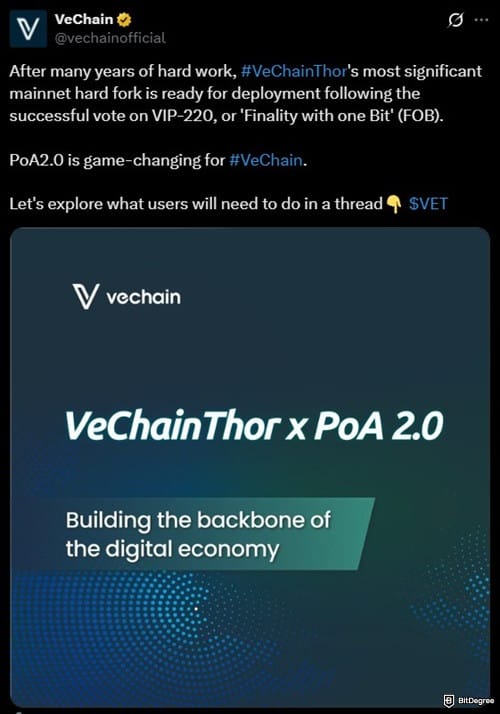
This arrangement may constantly change, as VeChain continues to upgrade PoA 2.0 with features like finality gadgets and randomization mechanisms. The upgrades make sure the blockchain is secure and resistant to attacks.
Dual-Token Economic Model
VeChain uses a two-token system that separates value storage from utility, aiming to make the blockchain more practical and cost-effective for real-world applications. VET (VeChain Token) is the main player in the ecosystem.
So, what is VeChain coin used for? It acts like the "currency" and "engine" of the network, representing value held by users, businesses, or developers. With a fixed supply of 86.7 billion tokens, VET can be sent, received, and staked like many other cryptocurrencies.
Now, what is the market cap of VeChain (VET)? As of today, VET’s market capitalization stands at approximately $2 billion, reflecting the growing interest in VeChain’s real-world utility and long-term sustainability goals.
However, it’s worth noting that VET alone isn’t used to pay for transaction fees. Instead, holding VET generates VTHO (VeThor Token), a secondary token of VeChain. It acts like the "fuel" of the network for covering transaction fees and smart contract executions on the blockchain. So, if you want to send data to the VeChainThor or run a decentralized app, you pay in VTHO.
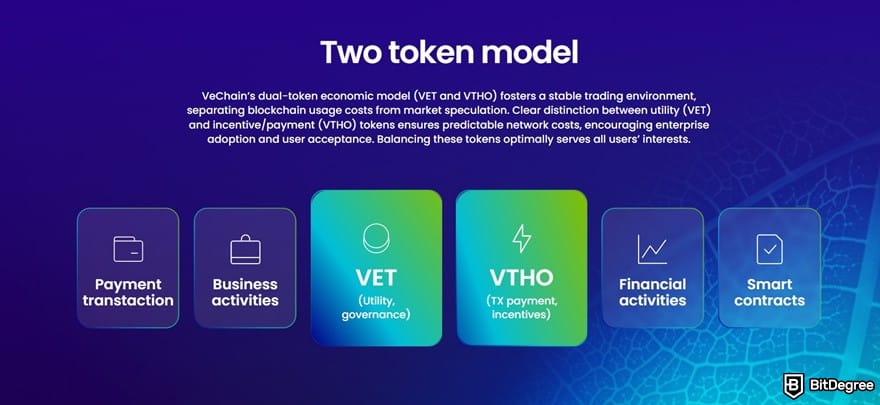
This setup keeps the cost of using the network more stable over time, helping businesses to forecast and manage costs since their operational expenses (in VTHO) aren’t directly affected by the market price of VET.
Instead of being surprised by high fees during times of market hype (like with many Ethereum-based apps), VeChain users can rely on predictable costs.
Interestingly, when you hold VET, the system automatically generates VTHO for you. This way, you only need to hold VET in your wallet to earn a steady stream of VTHO.
The amount of VTHO you receive depends on how much VET you hold and the current generation rate, which is about 0.00000005 VTHO per VET per block. Since the blockchain creates a new block roughly every 10 seconds, your wallet can steadily accumulate VTHO throughout the day.
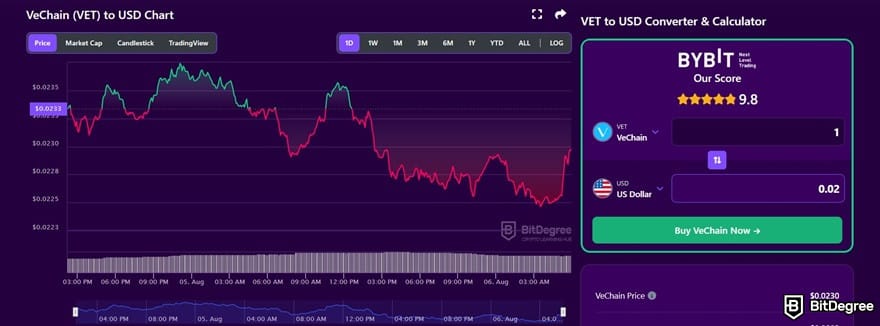
To put these VeChain stats into perspective, if you want to receive around 1 VTHO per day, you would need to hold about 2,314.8 VET. Plus, a portion of the VTHO used is burned (destroyed) with each transaction, which helps regulate the token supply and maintain network efficiency.
However, starting July 1, 2025, the Galactica upgrade launched a new gas fee market on the VeChainThor network, so 100% of the VTHO used in every transaction is burned. This helps reduce oversupply and supports long-term value for the token.
Looking ahead to December 2025 (as the Hayabusa phase of the VeChain Renaissance rolls out), new VTHO is only created by actively staking VET, not just passive holding.
This change helps reduce idle VTHO, such as tokens held in exchange wallets, aiming to limit surplus and ease overall inflation.
Enterprise Features
Beyond its core innovations like the PoA 2.0 consensus and dual-token model, VeChainThor offers several enterprise-focused features to make blockchain integration smooth and practical for real-world businesses.
One standout feature is "Fee Delegation". This allows a third party (an application or company) to cover the transaction fees on behalf of the end user. As a result, users can interact with the blockchain without needing to hold or manage VTHO, which lowers the barrier to entry, especially for those unfamiliar with crypto.
Another important capability is "Multi-Clause Transactions". This feature lets developers bundle some operations into a single transaction.
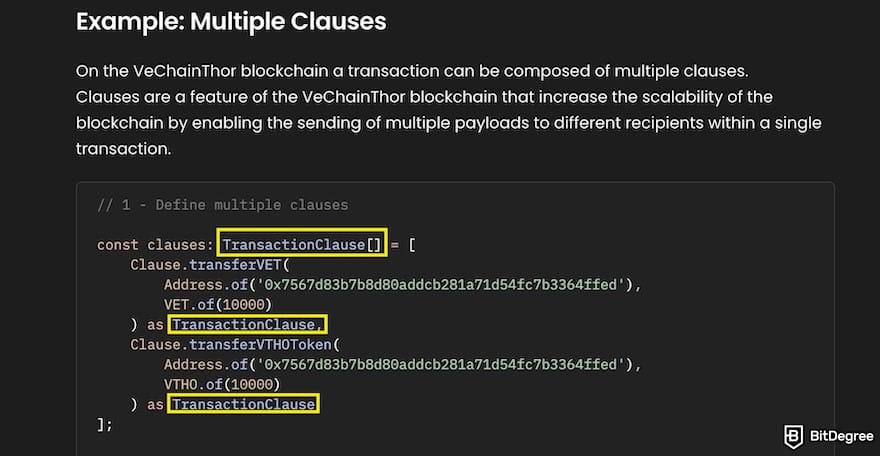
For example, a supply chain process that involves multiple steps, such as updating product status, verifying ownership, and issuing a certificate, can be executed in one go. This way, the blockchain applications are more efficient and consistent, especially when dealing with complex workflows.
Finally, VeChainThor offers a RESTful API layer for developers, unlike many blockchains that rely solely on lower-level JSON-RPC interfaces.
This feature is easier to work with and more identifiable by machines across networks,[2] so businesses can integrate blockchain into their existing tools without completely overhauling their tech stack.
📚 Read More: Why Blockchain for Enterprises Matters
VeChain Governance
VeChain’s governance framework serves as the backbone of its decision-making process. It has been in place since the early development of the network and plays a central role in managing and steering the ecosystem’s growth.
In addition to organizational decisions, the governance framework oversees technical and economic policies. This includes managing protocol-level changes, such as consensus upgrades or tokenomics adjustments, to ensure the blockchain remains secure and efficient.
At the heart of this governance system is the "Steering Committee", a group of elected members responsible for making decisions.
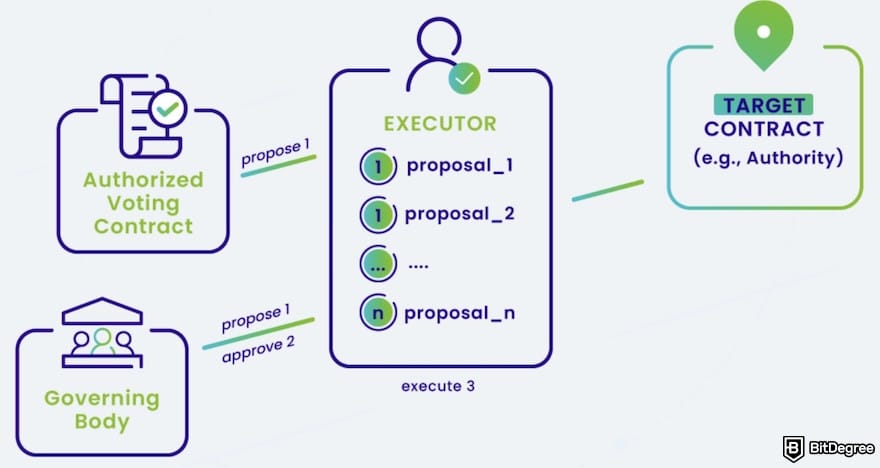
These members are selected through a voting process known as VeVote, which allows stakeholders (particularly enterprise participants and authority node holders) to have a say in key matters such as upgrades, technical proposals, and major partnerships.
Complementing the Steering Committee is the "VeChain Foundation", which executes the strategies and initiatives laid out by the Steering Committee. It also manages funding, community outreach, developer support, and business development efforts.

Did you know?
Subscribe - We publish new crypto explainer videos every week!
What is Yield Farming in Crypto? (Animated Explanation)



- Secure and reliable
- Accepts fiat currencies
- Lots of trading options
- Reputable exchange
- Accepts fiat currencies
- Offers various trading options

- Huge trading variety
- Regulation-compliant around the globe
- Fair trading fees
- Beginner-friendly
- A wide array of features
- Vast number of different crypto coins & tokens

- Beginner-friendly
- Secure
- Decent trading and withdrawal fees
- Crypto.com Visa Card
- Automated tools & bots
- Ecosystem synergy with CRO
VeBetterDAO and VeBetter
With all the features available for enterprises, what is VeChain used for by everyday people? While VeChain’s main governance framework handles big-picture decisions, including upgrades, partnerships, and network rules for mostly companies, there’s a new community-focused layer called VeBetterDAO.
VeBetterDAO is a decentralized platform built on VeChainThor that encourages the wider community to take part in socially responsible actions.
Joining VeBetterDAO also gives you a voice. With a token called VOT3, you can vote on proposals and help decide what the DAO focuses on next.
Still, VeBetterDAO uses a system called quadratic voting to keep things fair. This helps prevent any single person or group from dominating decisions just because they hold more tokens. Instead, it gives everyone a more balanced and meaningful say in the direction of the DAO.
![What is VeChain: the [Proposal] page on the VeBetterDAO website. What is VeChain: the [Proposal] page on the VeBetterDAO website.](https://assets.bitdegree.org/images/what-is-vechain-vebetterdao-proposal.jpg)
The proposal process in VeBetterDAO follows three clear and simple stages:
1
Community members submit their ideas;
2
Others provide feedback and suggestions;
3
Finally, everyone gets to vote.
It’s an open, transparent system that encourages collaboration from start to finish. While the VeChain Foundation initially helped launch VeBetterDAO, the goal is for it to operate independently in the long run.
VeChain’s enterprise-driven governance and VeBetterDAO’s community-first approach create a good combination of strategic oversight and grassroots participation.
Also, you can access the apps on VeBetter, a sustainability-focused Web3 app store. It uses the "X-to-Earn" model, rewarding users with B3TR tokens for eco-friendly actions like recycling, using public transit, or supporting eco-friendly platforms.
This platform has helped increase on-chain transaction volumes and wallet activity since the mainnet went live in June 2024. The recent launch of the Stella Pay Visa Card also opens the ecosystem further, as users can now spend their rewards at more than 130 million merchants across the globe.
More importantly, users logged impactful actions. The VeChain stats on the website show approximately 135,000 kg of plastic reduced, along with over 3 million liters of water saved, thanks to the network's dApp users.
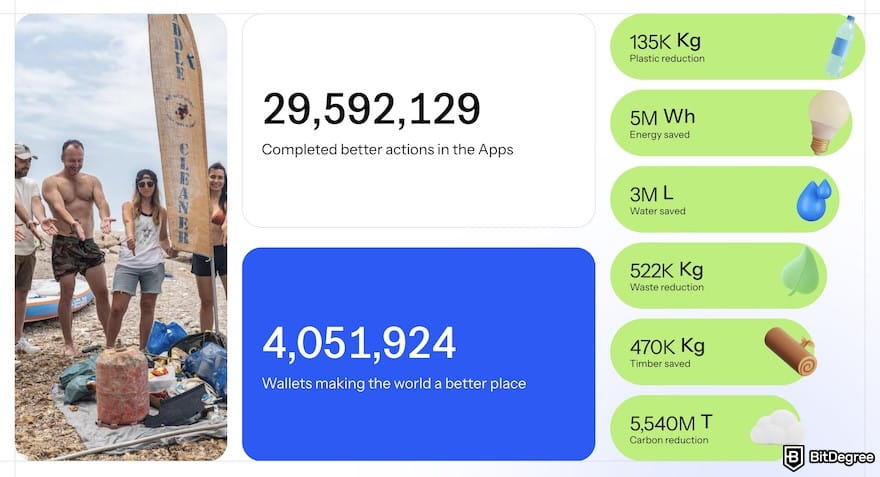
The VeBetter ecosystem includes many other dApps driving environmental impact:
- Cleanify. This app makes organizing or joining environmental cleanups easy. Participants earn B3TR for verified cleanup efforts, with waste type and weight data logged transparently on the blockchain. It’s already gained traction in Japan and South Korea.
- Green Commuter. It incentivizes greener travel by tracking and rewarding walking, cycling, or running. The app calculates carbon savings and distributes B3TR tokens accordingly.
- EVearn. This connects directly to Tesla vehicles via API, rewarding drivers for charging and driving electric cars. Support for more EV brands is expected soon.
- Build Your Body (BYB). It’s co-branded with the UFC, follows a “workout-to-earn” model, rewarding physical activity. Launched at UFC 317, it’s already made waves with the UFC’s global audience of over 1 billion.
Together, these apps reflect VeBetterDAO’s mission: to gamify sustainability, drive real-world behavioral change, and bring Web3 adoption into everyday life through token rewards. So, if you ever think, "Is VeChain dead?", the answer is a clear no. It’s actively reshaping how blockchain can serve the planet and the people on it.
VeChain Staking and Rewards Mechanism
VeChain has launched StarGate, the staking platform on the VeChainThor network. It's available starting July 1, 2025, right alongside the official release of the Galactica upgrade.
So, what is VeChain's StarGate all about? It marks a major step toward decentralization and broader community participation. First, the team removes the Know Your Customer (KYC) requirements for becoming a validator to allow more people to join in. The minimum entry is to stake 10,000 VET (around $233, at the time of writing).
Besides, VeChain introduces a brand new validator-delegator system. Now, anyone holding VET tokens can help secure the network by staking and delegating through NFT-based methods.
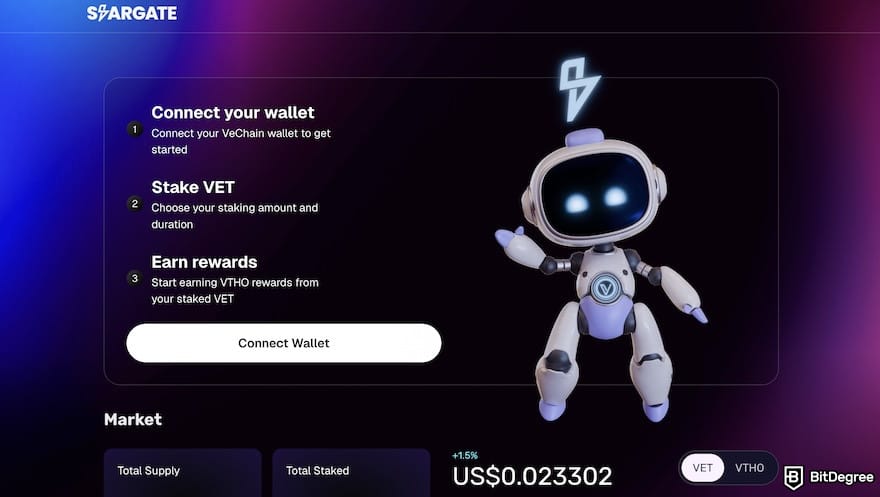
When you stake, you receive a Delegator NFT, which acts as proof of your stake and opens up more VeChain staking rewards and governance features.
To incentivize early adoption, VeChain has set aside a $15 million reward pool (equivalent to 5.48 billion VTHO tokens) available to new stakers and migrated node holders during the first six months. This way, early participants under the StarGate bonus program can get higher rewards.
Moreover, community-built tools like VeChainStats and Redeno allow you to simulate staking scenarios. Simply pick different node tiers and VET amounts to see potential yields before you stake.
📚 Read More: How to Stake Crypto
Benefits of Using VeChain
VeChainThor is built for real-world adoption, especially in enterprise and supply chain use cases. It combines technical innovation and practical functionality to address many of the common pain points found in some other blockchain platforms.
Here are some of its standout features that make it reliable, scalable, and user-friendly:
1
Scalability. VeChain uses an advanced transaction model that supports asynchronous operations and allows transactions to depend on one another, ideal for handling complex business workflows.
2
Cost predictability. Thanks to the dual-token model (VET and VTHO), transaction fees remain stable and predictable, even during periods of high network activity.
3
Sustainable consensus. It runs on a Proof of Authority mechanism that delivers strong security and scalability while keeping energy use and carbon emissions minimal.
4
Fee delegation. The blockchain lets sponsor accounts cover transaction fees for users, removing one of the biggest onboarding barriers and making blockchain usage more accessible.
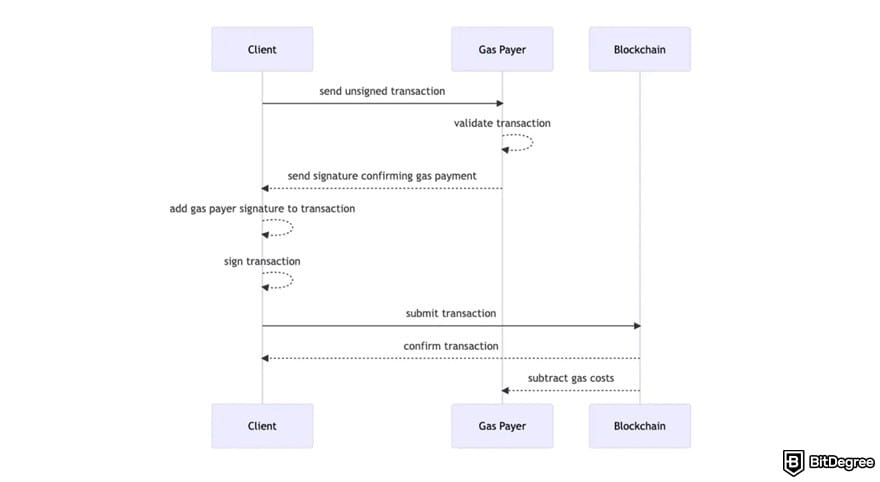
5
Strong security. Since its launch, there have been zero reported hacks related to VeChainThor’s PoA consensus, which can be a strong indicator of its security resilience.
6
High reliability. The network has run continuously without downtime since its genesis block in 2018.
7
Interoperability. It’s designed to be compatible with other major blockchain ecosystems, making it easier to integrate VeChain into broader enterprise or multichain environments.
All of these features reflect VeChainThor’s focus on enterprise-grade performance without compromising usability or sustainability. This is particularly valuable for developers and businesses that want to build eco-friendly and high-performing solutions.
The VeChain Blockchain: Use Cases
VeChain has already powered production deployments for over 30 Fortune 500 companies, delivering real-world use cases across industries.
For instance, Walmart China launched its Food Safety Traceability Platform in collaboration with VeChain, PwC, and the China Chain‑Store & Franchise Association in 2019. The system began covering 23 SKUs, including pork, vegetables, mushrooms, and cooking oil.
What is VeChain used for in this case? With every product tag linked to a VeChain blockchain record, consumers can scan a QR or NFC tag to view verified details: the product’s origin, journey, temperature logs, inspection data, and more. This creates data integrity, faster recalls, and improved consumer trust across major product categories.
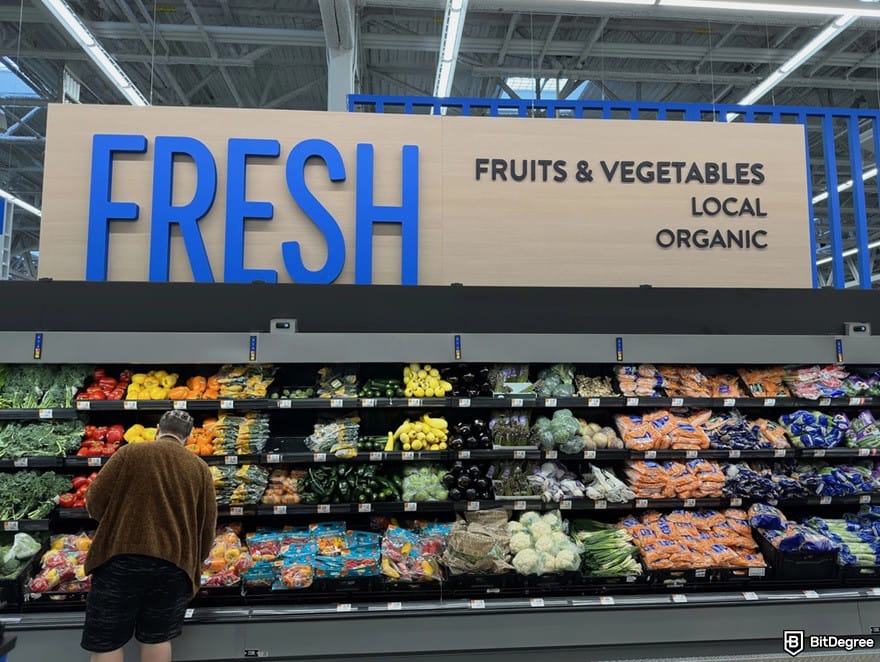
Luxury brands under LVMH also use VeChain to ensure product authenticity, using NFC or QR codes embedded into items. Each scan links the product to a blockchain-based record that tracks its lifecycle, from material sourcing to retail delivery.
As such, consumers can instantly verify that their goods are genuine, and the technology mitigates counterfeiting risks.
In 2018, VeChain was selected as one of 30 finalists out of more than 800 startups for the LVMH Innovation Award at the Viva Technology conference in Paris.
Although VeChain didn’t win the grand prize, the recognition gave the network exposure and credibility. Bernard Arnault, CEO of LVMH, and other top executives noted VeChain’s ability to help defend brand integrity via blockchain authentication.
In the automotive sector, VeChain collaborates with BYD Auto and Renault to enable tamper-proof digital maintenance records and carbon credit tracking. For BYD, users receive rewards for reduced emissions, clean driving habits, and sustainable habits, all recorded on the chain.
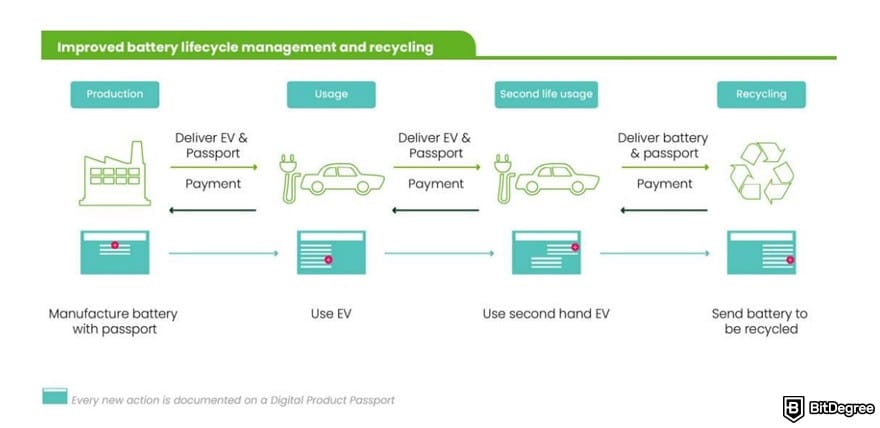
Meanwhile, Renault collaborated with Microsoft and VISEO to build a blockchain-based digital vehicle maintenance book (a "car passport"), which stores tire services, mileage, and repair history in a tamper-proof way.
This system lets car owners securely share verified vehicle data with insurers, dealers, and buyers. It addresses fraud and data fragmentation by giving vehicle histories a trustworthy record, which can benefit resale value and consumer confidence.
Conclusions
So, what is VeChain doing differently? Instead of chasing hype or speculative financial trends, VeChain focuses on practical, real-world solutions that matter to businesses and the planet. It helps authenticate luxury goods or track food safety, proving that blockchain can be a tool for trust and sustainability.
If you're planning to interact with the VeChain ecosystem, using a hardware wallet like Ledger Stax or Ledger Flex is one of the most secure ways to store your VET and VTHO tokens. The wallet keeps your private keys offline, protecting your assets from hacks or phishing attacks.
Learn how to keep your crypto safe with Ledger by checking this BitDegree Mission.
The content published on this website is not aimed to give any kind of financial, investment, trading, or any other form of advice. BitDegree.org does not endorse or suggest you to buy, sell or hold any kind of cryptocurrency. Before making financial investment decisions, do consult your financial advisor.
Scientific References
1. Dutta P, Choi T, Somani S, Butala R.: 'Blockchain Technology in Supply Chain Operations: Applications, Challenges and Research Opportunities';
2. Ehsan A., Abuhaliqa M. A. M. E., Catal C., Mishra D.: 'RESTful API Testing Methodologies: Rationale, Challenges, and Solution Directions'.
